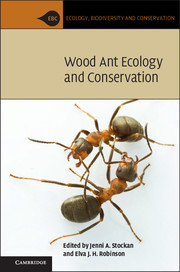Book contents
- Frontmatter
- Dedication
- Contents
- List of contributors
- Foreword
- Acknowledgements
- 1 Introducing wood ants: evolution, phylogeny, identification and distribution
- 2 Wood ant reproductive biology and social systems
- 3 Population genetics of wood ants
- 4 Where and why? Wood ant population ecology
- 5 Colony and species recognition among the Formica ants
- 6 Interspecific competition and coexistence between wood ants
- 7 Wood ant foraging and mutualism with aphids
- 8 Wood ants and their interaction with other organisms
- 9 Contribution of wood ants to nutrient cycling and ecosystem function
- 10 Diversity, ecology and conservation of wood ants in North America
- 11 Sampling and monitoring wood ants
- 12 Threats, conservation and management
- 13 Future directions for wood ant ecology and conservation
- Index
- References
10 - Diversity, ecology and conservation of wood ants in North America
Published online by Cambridge University Press: 05 June 2016
- Frontmatter
- Dedication
- Contents
- List of contributors
- Foreword
- Acknowledgements
- 1 Introducing wood ants: evolution, phylogeny, identification and distribution
- 2 Wood ant reproductive biology and social systems
- 3 Population genetics of wood ants
- 4 Where and why? Wood ant population ecology
- 5 Colony and species recognition among the Formica ants
- 6 Interspecific competition and coexistence between wood ants
- 7 Wood ant foraging and mutualism with aphids
- 8 Wood ants and their interaction with other organisms
- 9 Contribution of wood ants to nutrient cycling and ecosystem function
- 10 Diversity, ecology and conservation of wood ants in North America
- 11 Sampling and monitoring wood ants
- 12 Threats, conservation and management
- 13 Future directions for wood ant ecology and conservation
- Index
- References
Summary
The North American Formica rufa group ants (henceforth, North American wood ants) have great inherent interest, but they are relatively little studied. None of the North American wood ants enjoys much recognition in the minds of North American peoples. Aside from the moderately abundant literature on F. obscuripes, the literature on North American red wood ants is characterised by dearth, in comparison to the rich literature on the Eurasian species. Much of what we know about the species is summarised in regional faunas (e.g. Creighton 1950; Wheeler and Wheeler 1963, 1986; Gregg 1963; Mackay and Mackay 2002; Coovert 2005; Ellison et al. 2012; Talbot 2013) and in original descriptions (not cited but available through Bolton 2013). The United States, Canada and Mexico lack the legal protection of these ants such as occurs in European countries.
The designation ‘wood ants’ is, in truth, an inadequate descriptor for the North American F. rufa group species, as many of these species inhabit shrub lands or grasslands. The majority of North American species rarely have an organic mound-building habit, or it is certainly not well developed. Furthermore they lack, or are less likely to develop, the polygynous supercolonies that are characteristic of the Eurasian red wood ants of mature forests. These habits render them less conspicuous to entomologists and non-entomologists alike. This chapter explores the ecological differences between North American and Eurasian wood ants and discusses the possible reasons for these differences.
The Formica rufa group in North America
The F. rufa group is represented by at least 20 to perhaps 50 species in North America, depending on how inclusive the group is deemed to be, and accounting for undescribed (S. Cover, unpublished data, 2014) and introduced species (i.e. Formica paralugubris). The majority of the North American red wood ants are rare or sporadic in distribution, and the taxonomy of these forms is in a relatively poor state, with sometimes less than clear species delimitations (see key in Chapter 1). The taxonomic picture is further complicated by the fact that American ant taxonomists generally believe the North American red wood ants properly ought to include the species that have been separated as the Formica microgyna group (in this chapter referred to as the F. microgyna complex).
- Type
- Chapter
- Information
- Wood Ant Ecology and Conservation , pp. 221 - 237Publisher: Cambridge University PressPrint publication year: 2016
References
- 2
- Cited by

